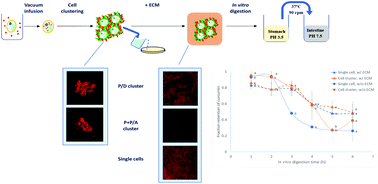Engineering cell-based microstructures to study the effect of structural complexity on in vitro bioaccessibility of a lipophilic bioactive compound†
Abstract
A fundamental understanding of the influence of food microstructures on the bioaccessibility of micronutrients is vital for the design of functionally efficient foods. This study investigated the effect of microstructural features of model foods on the bioaccessibility of a bioactive compound – curcumin, using a unique bottom-up approach. In this approach, individual yeast cells with infused curcumin were coated with oppositely charged polyelectrolytes: first in poly(diallyl-dimethylammonium chloride), then in dextran sulfate or alginate, and assembled electrostatically to generate two types of cell clusters. These cell clusters were embedded in an alginate film to form a tissue-like structure. The influence of cell clustering and extracellular matrix on the release of encapsulated curcumin from cell-based microcarriers during simulated digestion was evaluated. Cell clusters that maintained their integrity during in vitro simulated digestion retained up to twice as much curcumin upon addition of the simulated intestinal fluid (SIF) compared to single cells during the first hour of intestinal digestion. Despite significant differences in the release profile, no spatial heterogeneity of curcumin release across a cell cluster was observed with the imaging measurements. Embedding single cells or cell clusters in calcium-crosslinked alginate films resulted in another 20–30% increase in curcumin retention and a prolonged barrier effect for more than 2 hours compared to microstructures without the films. This bottom-up approach of engineering cell-based tissue-like structures proves to be an effective method for investigating the contributions of microstructural properties of food matrices to influencing bioaccessibility of bioactives and guides future development of functional food materials.

- This article is part of the themed collection: Food & Function HOT Articles 2022


 Please wait while we load your content...
Please wait while we load your content...